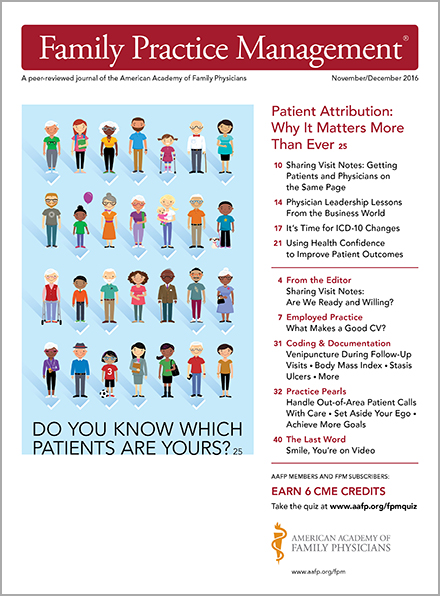Techniques to Alleviate Quality Measurement Burden
The AAFP offers practical techniques any family physician can adopt to reduce burden without significant expense or oversight. These techniques can simplify your process by improving workflow in four main areas.
Plan ahead
How to make the clock work for you.
Use data efficiently
Make sure you’re getting the right information.
Code correctly
Are you billing for the correct service?
Try team-based care
Optimize individual strengths to improve everyone’s well-being.
Practitioners working in value-based care must manage high-risk patients, helping them avoid costly care, and document that care.
Schedule adequate time
To address the multiple, complex medical issues of older or sicker patients during their visits, consider creating appointment time slots appropriate to managing such patients; 30 to 40 minutes may be required in some cases, rather than the standard 15 to 20 minutes.
Incorporate clinical quality measure review in your pre-visit planning
Because different payers and programs require different quality measures, it’s important to capture the right measures for each patient. Include review of clinical quality measures for the patient during your pre-visit planning routine so you can focus on closing care gaps and capturing the correct data.
Make sure you are tracking the right data for your patients. Your EHR should provide ready access to each patient’s quality metrics.
Capture the data in the right place in your EHR
Ensure that you and your care team know how and where to capture key data points in your EHR so they can be tracked and reported. Most EHRs include quality reporting options. Make sure that you and your care team verify that this function is on and producing the reports you need. Do not wait until the end of the reporting period.

FPM: Patient Attribution: Why It Matters More Than Ever
Understanding how attribution works is an important first step to succeeding in the new payment environment. Knowing which patients are attributed to you by each payer, and how value-based payment programs affect different segments of your patient population, will help you target your health care team’s resources most effectively.
Correct coding is vital to your compensation. To ensure that you and your team optimize the coding process and your practice is compensated appropriately, start by making certain that your documentation always matches the services performed.
Go deeper with these Academy resources:
Family medicine practices nationwide are shifting to team-based care because it improves the patient-physician relationship, increases efficiency, and supports physician and employee well-being. Team-based care achieves these improvements by more appropriately distributing the workload and capitalizing on each team member’s separate strengths to maximize total practice efficiency.

Mythbusting Team-based Care
Three common myths prevent physicians from buying into team-based care:
- Staff can’t take on additional clinical skills.
- Having staff in the exam room will interfere with the physician-patient relationship.
- Patients don’t want staff in the exam room.